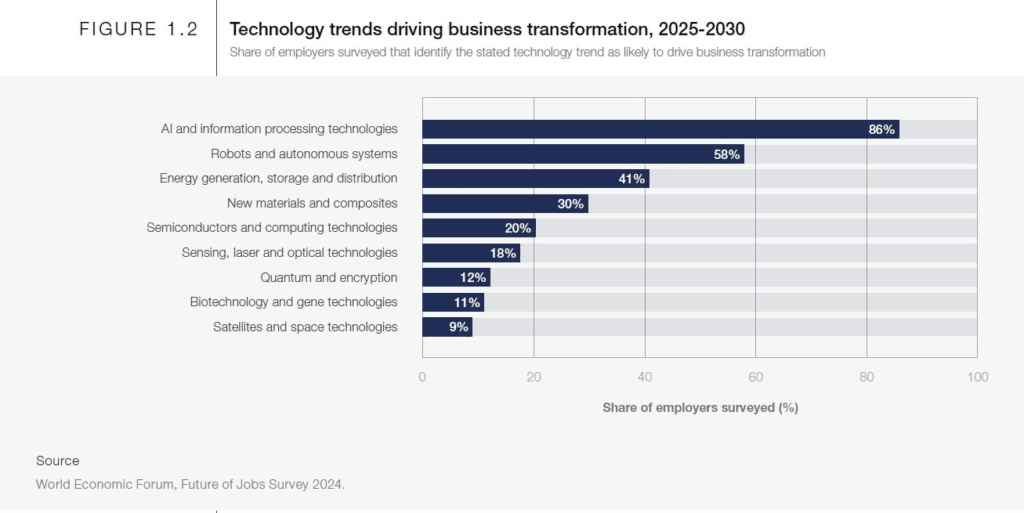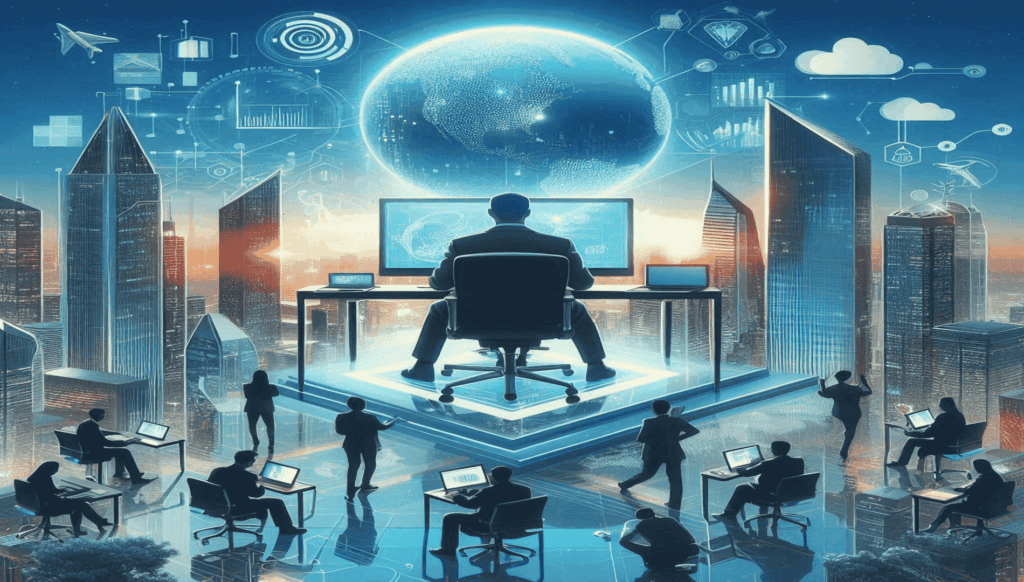
The world of work is changing, and it is changing fast. With the rapid advancements in technology, shifting economic landscapes, and evolving societal expectations, businesses are facing an unprecedented level of disruption. In this environment, future workforce strategies are not just a nice-to-have, they are essential for survival and growth. The “WEF Future of Jobs Report 2025” provides a comprehensive analysis of these changes and offers key insights into how organizations are adapting to this new reality. This report, based on a survey of over 1,000 leading global employers, offers a roadmap for businesses looking to thrive in this new era.
The Foundation of Future Workforce Strategies: Upskilling and Reskilling Initiatives
One of the most striking findings from the “Future of Jobs Report 2025” is the emphasis on upskilling and reskilling. According to the survey, 85% of employers plan to prioritize upskilling their current workforce. This means that a significant majority of businesses are recognizing the need to invest in their employees’ existing skills and teach them new capabilities. After all, as the report indicates, skills gaps are considered the biggest barrier to business transformation, with 63% of employers identifying them as a major obstacle. Therefore, it is hardly surprising that employers are focused on upskilling.

85% of employers plan to prioritize upskilling their current workforce.
emphasising Furthermore, this isn’t just about tweaking existing skills; it’s about preparing workers for entirely different roles as well. The report indicates that 50% of employers plan to transition staff from declining to growing roles, highlighting the importance of internal mobility programs. To illustrate, if we consider the workforce as a group of 100 individuals, employers expect that 29 of them will need upskilling within their current roles, while 19 will require reskilling and redeployment within the organization by 2030. These initiatives, in my opinion, reflect a proactive approach by organizations to adapt to the changing landscape. Funding and provision of these reskilling programs are seen as the two most welcomed public policies to boost talent availability emphasising their crucial role.

50% of employers plan to transition staff from declining to growing roles
The Dual Approach: Automation and Augmentation in Future Workforce Strategies
While upskilling and reskilling are crucial, they are not the only strategies businesses are employing. Automation and augmentation also play significant roles in the future workforce strategies being implemented across the globe. Indeed, the “Future of Jobs Report 2025” notes that 73% of employers plan to accelerate the automation of processes and tasks, indicating a shift towards integrating technology into operations. But it’s not about simply replacing human workers with machines. Rather, 63% of employers plan to complement and augment their workforce with new technologies, pointing toward an increasing focus on human-machine collaboration.
What does this mean in practice? Well, some industries lean heavily towards automation, while others prefer augmentation. The Electronics sector, for instance, appears to favour automation, while industries such as Healthcare and Agriculture show a preference for augmentation. Interestingly, geographical differences also emerge in this regard, with companies in Eastern Asia planning to invest in both automation and augmentation technologies. Moreover, when it comes to AI, the majority of businesses are focusing on reskilling their current employees to work alongside AI, as well as hiring people with skills to develop and operate these technologies. This shows that technological change is not a linear force, but rather a nuanced and complex trend that affects different industries and regions in unique ways.
Talent Attraction and Retention: The Human-Centric Approach
In the face of these changes, attracting and retaining talent is becoming an increasingly critical component of future workforce strategies. The “Future of Jobs Report 2025” reveals a notable shift toward human-centric approaches. Supporting employee health and well-being is now a top priority, with 64% of employers identifying it as a key strategy to increase talent availability. Other significant initiatives include providing effective reskilling and upskilling programs (63%), improving career progression and promotion (62%), and offering competitive salaries (50%). These approaches highlight a growing recognition that employees are not just resources, but rather valuable assets that need to be nurtured and valued.

Supporting employee health and well-being is now a top priority
Furthermore, tapping into diverse talent pools is also gaining prominence, with 47% of employers recognizing its potential. This represents a significant increase from previous reports and indicates the importance of skills-based approaches that expand the potential talent pool. Employers are increasingly interested in attracting and retaining talent through diversity, equity, and inclusion, including setting DEI goals, offering DEI training and implementing DEI initiatives across supply chains. By including a wide variety of people, organizations can tap into a rich source of ideas, skills, and experiences. Also, companies in certain industries such as Accommodation, Food, and Leisure are focusing their DEI efforts on young talent and migrant workers to address specific needs and demographics.
Addressing Talent Shortages and Skills Gaps in Future Workforce Strategies
One of the most significant challenges highlighted in the “Future of Jobs Report 2025” is the growing concern about talent shortages and skills gaps. 63% of employers see these gaps as the biggest barrier to business transformation. Many employers are expecting talent availability to worsen, which means that finding the right people, with the right skills, is becoming increasingly difficult. Indeed, the report also indicates that skill gaps in the labour market are among the top barriers to transformation for organizations in the Chemical and Advanced Materials sector.

63% of employers see skill gaps as the biggest barrier to business transformation.
Different regions and industries are facing varying degrees of these challenges. For instance, 56% of firms in the Netherlands expect hiring difficulties, while companies in Eastern Asia point to resistance to change and organizational culture as key barriers to transformation. To deal with these shortages, companies are adopting various strategies. Companies in the Netherlands plan to automate their processes, while firms in Japan and Hong Kong are seeking to utilize diverse talent pools, and businesses in Poland are providing cross-border remote work opportunities. In my view, it’s clear that there is no one-size-fits-all solution to the talent shortage, but rather a need for localized and tailored strategies.
The Role of Public Policy in Shaping Future Workforce Strategies
The “Future of Jobs Report 2025” also highlights the crucial role of public policy in shaping future workforce strategies. As discussed, the funding and provision of reskilling and upskilling programs are considered the most welcomed public policies for boosting talent availability. Also, the report suggests that businesses would benefit from public support through better wage subsidies and more flexibility in wage settings. For example, in Nigeria, firms have indicated that increased public funding for reskilling and upskilling programs, as well as better infrastructure, would be important for talent availability. Similarly, the Electronics industry has also expressed a need for improved transport infrastructure to enhance talent availability.
These findings underscore that future workforce strategies are not just the responsibility of employers; they require a collaborative effort between the private and public sectors. Governments need to step in with supportive policies to help workers and companies adjust to the ever-changing landscape. In my opinion, this is essential for ensuring a smooth transition and creating a more inclusive and equitable future for work.
Regional and Industry Variations in Future Workforce Strategies
It is important to highlight that future workforce strategies are not uniform across different regions and industries. The “Future of Jobs Report 2025” provides detailed profiles that show the varying approaches and priorities of different sectors. For example, companies in Eastern Asia anticipate an ageing and declining working-age population and slower economic growth, which is why they focus on technology to automate and augment their workforce. In contrast, companies operating in Sub-Saharan Africa are navigating significant transformation barriers like skills gaps and lack of capital, and so are focused on workforce development.
Similarly, different industries are also pursuing unique future workforce strategies. The Automotive and Aerospace sector is dealing with issues of climate change and geoeconomic fragmentation and has therefore focused on upskilling, automation, and transitioning staff to growth roles. The Chemical and Advanced Materials sector is struggling with attracting talent to their industry and is therefore working to improve talent progression and promotion, supporting worker health, and offering better wages. These variations emphasize the importance of having tailored and localized approaches for different businesses.
The Technological Imperative: AI and the Future of Work

AI’s impact on future workforce strategies is significant and undeniable.
The role of AI in shaping future workforce strategies cannot be overstated. The “Future of Jobs Report 2025” highlights that AI and information processing technologies are expected to be a major driver of business transformation. This has significant implications for the types of skills that will be in demand in the future. As the report indicates, AI and big data are among the fastest-growing skills, followed closely by networks and cybersecurity and technological literacy. Also, there are specific roles such as AI and Machine Learning Specialists which are projected to have high demand.
However, the report also makes it clear that AI is not meant to replace humans entirely. The emphasis is on the collaborative potential of humans and machines. The report argues that technology development should focus on enhancing human capabilities, rather than substituting them. Furthermore, the report finds that skills requiring nuanced understanding, complex problem-solving, or sensory processing show less risk of being replaced by GenAI. Therefore, the emphasis needs to be on upskilling programs that will enable workers to effectively collaborate with AI technologies.
The Shifting Sands: Evaluating Skills in the Future Workforce Strategies
A critical element of effective future workforce strategies is how organizations evaluate skills. The “Future of Jobs Report 2025” notes a shift from traditional methods to more practical and direct approaches. Evaluation of work experience is now the most prioritized way to assess skills, with 81% of employers using this method. Skills assessments are also gaining in importance, with 48% of businesses using them. Psychometric testing is utilized by 34% of companies, reflecting an increased focus on candidate’s cognitive and behavioral traits, and their cultural fit.

Evaluation of work experience is now the most prioritized way to assess skills
While a university degree is still a factor, with 43% of employers continuing to use it as a requirement, it’s less of a priority than in previous years. What’s more, the report indicates that work experience and psychometric testing are of growing importance when compared to university degrees. This signals a growing understanding that practical skills, cognitive abilities, and experience are important for successful job performance and that they should be considered alongside educational credentials. In my opinion, this shift is necessary to make sure that businesses can tap into a wide talent pool and hire the most qualified individuals.
Here’s What I Think:
In conclusion, the “Future of Jobs Report 2025” provides invaluable insights into the evolving world of work. Organizations must be proactive and strategic in their approach to workforce planning. The emphasis on upskilling, reskilling, automation, augmentation, talent availability, diversity, and public policy highlights the many facets of a successful workforce strategy. The rise of AI and technology means that companies must carefully plan how to integrate these technologies to leverage both human and machine capabilities. And finally, by evaluating skills through experience, assessments, and psychometric tests, businesses are now in a better position to hire people based on what they can do. Therefore, by embracing the findings of the report, organizations will be well-positioned to thrive in the future, making the necessary adjustments to not just survive, but to succeed in this rapidly changing landscape.
Sources of Insights
World Economic Forum. (2025). The Future of Jobs Report 2025.

Ajay Dhage is a seasoned Talent Acquisition leader with over 20 years of experience in recruitment and workforce strategy. Currently serving as the Talent Acquisition Lead for a global Oil & Gas EPC Company in India, ajay oversees the entire talent acquisition lifecycle across diverse and complex projects, from sourcing to onboarding and aligning top talent with complex organizational goals. With a proven track record in industries such as oil and gas, EPC, and renewables, he brings a customer-focused approach and innovative mindset to every project.
Through ajayable.com, ajay aims to share insights, trends, and strategies to empower HR professionals, Organizations and recruiters to excel in a competitive talent landscape.








